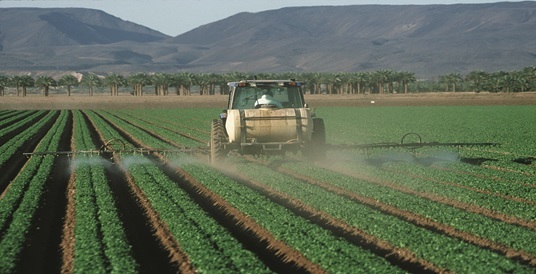
Ethiopia is the second populous country in Africa with about 120 million people of which nearly 80% is residing in the rural part of the country engaged in agriculture.
Much has been said about the sector, that on top of mostly traditional, it is highly vulnerable to climate change. It utilizes fewer inputs such as fertilizer, selected seeds and irrigation system resulted in less output.
The Ministry of Agriculture since its establishment in 1907 during the reign of emperor Menilik II, tried its level best to improve the sector’s production and productivity through providing extension services and inputs but though some achievements are registered, the nation is still categorized as food insecure country.
In the past decades, successive governments have exerted their energy for the betterment of the sector. Among the various measures that had been taken to modernize the sector was establishing educational institutions in 1950s and obtaining technical and financial support from countries such as the USA and Sweden.
The establishment of Haromaya and Jimma agricultural colleges with the support of USA enabled the country to produce educated man power helpful to upgrade the status of the sector.
It paved way to conduct various studies and research on the sector and the documented outputs of the studies still exist and being utilized by researchers for reference. In the later decades more educational institutions have been established and continued to produce trained man power.
As it is remembered, earlier to the Ethiopian revolution in 1974, the economic system was old and backward feudal. Farmers had no tenure security and obtained only portion of their products and the sizable portion of their products were taken by the feudal landlords who resided in towns particularly in the capital. The relation between tenants and land lords was characterized by oppression and exploitation and ultimately hampered enhancing agricultural production and productivity. In addition to the feudal system, the vulnerability of the sector to natural calamities left it to be stagnant.
The abolition of the feudal system in 1974 though freed farmers from the exploitation and oppression of feudalism, it did not bring tenure security to farmers and attaining agricultural advancement remained intact. To date, farmers have only right of using the land and it has no transaction value because it is the property of the people and the government as per the proclamation enacted by Derg in 1975.
That time, the regime pursued socialist economic system which denies the flourishing of private investment and till now the land tenure system hampers the inflow of private agricultural investment to the rural parts. And one can argue that the tenure system is unable to create enabling environment to resolve the century old problems witnessed in the sector.
Ethiopia is known by its largest cattle population in Africa but the contribution of the sector to the nation’s Gross National Product is insignificant.
According to the recent studies in Ethiopia less than 30% of farmers utilized modern agricultural inputs such as fertilizer, pesticide and herbicide. Only five percent of the nation’s water resource is used for both small and large scale irrigation farm. Hence, to advance the sector’s productivity, more investment should be pumped in the sector.
Recently, the United Nations Food and Agriculture Organization (FAO) expressed commitment to support efforts of the Ethiopian government to make sure that the agriculture sector is performing to its full potential, FAO Representative in Ethiopia, Farayi Zimudzi said.
The representative told ENA that FAO’s main purpose is to support member states such as Ethiopia in the agriculture sector to ensure that agri-food systems are not only sustainable, but also productive.
FAO has been implementing a four year program framework in Ethiopia that covers a period from 2020 to 2025, which is very much rooted in the strategic priorities of the government of the country in the agriculture sector, she elaborated.
She said, “We are focusing on ensuring that production and productivity is improved. We are also focusing on ensuring that issues around agri-food systems in general are also supported to be more sustainable and vibrant.”
According to the representative, FAO is in Ethiopia to provide the necessary support with a view to making sure that the agriculture sector is performing to its full potential.
Moreover, Zimudzi stated that FAO is looking for supporting the management of natural resources as agriculture depends on natural resources, the soil, the forests, water, and other resources to be there and managed in a sustainable manner.
In this regard, she noted that Ethiopia’s Green Legacy Initiative that focuses on planting of trees to make sure that the country is green for the benefit of its people.
The initiative is being implemented in Ethiopia for the last four years with the objective to mitigating the challenges of climate change and ensuring food security by increasing the nation’s forest coverage.
“The Green Legacy is an ambitious program, I think probably unprecedented on the African continent and perhaps even globally, and it’s really good to see the effort and the focus that is going towards this program. I was fortunate to participate in some of the activities in the last few weeks in terms of supporting the initiative,” she said.
Part of the work that FAO does is also around forestry and agro forestry in addition to other aspects like agronomy, plant protection and production, Zimudzi added.
“We have ongoing efforts to work together with the government in supporting those initiatives and we continue to be committed to ensure that we will work together with all stakeholders including the government in terms of making sure that the green legacy is a success because the future of Ethiopia and the future of the planet depends on such initiatives and we need to support them.”
FOA is also engaged in the prevention of natural disasters such as droughts, outbreaks of diseases and pests that affect the agriculture sector, the representative indicated.
“Currently, we are working together with the Ministry of Agriculture and various regions in terms of responding to this. There is a desert locust issue that we are also working together with partners and the government,” she noted.
As mentioned above, the sector is vulnerable to various types of natural disaster including drought and flood. On the other hand, due to population growth particularly in the highland parts of the country, the agricultural land size is dwindling from time to time which results in reducing soil fertility.
Shortage of agricultural and grazing lands also forces farmers to aggrandize forest which again threatens the utilizing of land sustainably.
According to the Central Statistics Agency recent report, almost 50% of farmers in the country have less than one hectare land and in such a situation, enhancing agricultural production and productivity is unthinkable.
When agriculture is subsistence and the size of land is shrinking, utilizing technology, inputs and practicing irrigation system is not feasible because it needs large land and extensive farming.
The ongoing tree planting via the green legacy initiative has a multifaceted benefit to the agricultural sector. Tree planting helps to contain soil erosion and enables protect land degradation that resulted in accelerated agricultural production.
Not only these, it also helps replenishing underground water, protect wet lands from flood and dumped soil, contain desertification and enhance the volume of the flow of water to rivers which find its way to hydropower and irrigation dams.
As it is understood, the agriculture sector, though subsistence, it plays pivotal role in the whole economy. It is a means of living for 85% of the population particularly residing in the rural part of the country; supplies food to the market; it contributes more than 80% of export earnings and supply raw material to agro industries.
As mentioned above, Ethiopia has abundant water resource which can be used for agricultural cultivation but only five percent of the water is utilized for irrigation. Irrigation development is taking place through the use of government budgets, donor programs and NGOs. However, As compared to its potential and rain-fed farming, contribution of irrigation to the national economy is quite limited which is about 2.5% of the overall economy.
In the last two decades, small and medium sized irrigation farming is expanded with its own shortcomings such as dwindling of water volume, the out of use of pumps and lack of spare parts and outbreak of water related diseases.
On the other hand, the cultivation of wheat through irrigation in the dry season brought a glimpse of hope to make the country food self -sufficient. Hence, it is vital to pay special attention to replicate the achievement registered in wheat farm in the other parts of the country.
BY ABEBE WOLDEGIORGIS
The Ethiopian Herald August 30/2023





